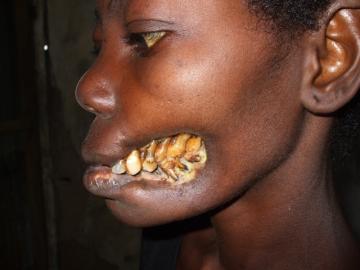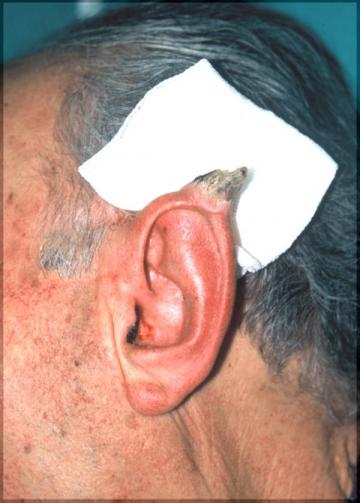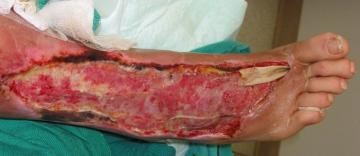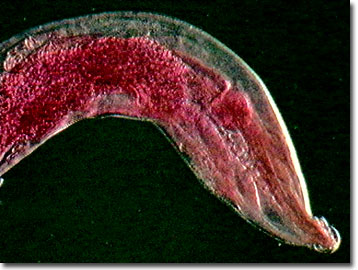Sneezing, runny nose, headache – you call that suffering? Your garden variety cold or flu is the bunny slope on the ski resort of ill health. How about worms burying through your flesh, skin peeling off, or uncontrollable vomiting for hours at a time? Now THAT’S an ailment! We’ve scoured the festering, pus-filled globe to find you ten of the most disgusting diseases.
10. Cyclic vomiting syndrome
Even when it makes you feel better after 9 headrest margaritas, blowing beets is no picnic. Now imagine doing it once every 5 minutes. For two hours. Episodes of cyclic vomiting syndrome including severe vomiting, nausea and gagging usually begin at night or first thing in the morning and may include barfing as often as six to 12 times an hour. Episodes usually last anywhere from 1 to 5 days, though they can last for up to 10 days.
In addition, the vomiting may cause drooling and excessive thirst. Drinking water usually leads to more vomiting, though the water can dilute the acid in the barf, making the episode a little less painful. Well, that’s a relief.
Cyclic vomiting syndrome can’t be cured, but it can be treated with drugs that are also used for migraine headaches, which prevent episodes, reduce their frequency, or lessen their severity.

Fish odor syndrome
9. Fish odor syndrome
What’s that smells like fish? Could be trimethylamine (TMAU) or “fish odor symptom” which causes an offensive body odor released in the sweat, urine, and breath. Although they show no apparent lack of hygiene or obvious medical symptoms, most people with the disorder report having foul body odor, bad breath, or a bad taste in their mouths (as do their friends, I suppose)
Studies seem to indicate that TMAU results from defects in an enzyme that breaks down trimethylamine, a byproduct of protein digestion released by bacteria living in the gut. This small molecule-the same compound that makes fish smell that way-smells garbage at low concentrations and fishy in larger amounts.
Although there is no cure for fish odor syndrome, a special diet can help alleviate the worst of the odor problems. This low-protein regime restricts the amino acid choline, a building block of protein naturally found in high concentrations in fish, eggs, beans, and organ meats. Some people also report that limiting lecithin, a common food additive found naturally in eggs, soybeans, and corn also helps reduce odor.

Dracunculiasis
8. Dracunculiasis
It’s no surprise you can get sick from drinking unfiltered pond water out in the middle of nowhere, but the disgusting part is how you become infected by Dracunculiasis, or Guinea worm disease (GWD).
Here goes: The adult female Dracunculus medinensis worm deposits larvae in water where water fleas can eat them up – but they don’t die. Instead, the larvae live inside the fleas and become infective in about two weeks. Humans then drink the water with the fleas carrying the infective larvae. Once inside the body, the stomach acid digests the water flea, but not the Guinea worm. These larvae migrate through the body to the small intestine, where they penetrate the wall of the intestine and pass into the body cavity. During the next 10-14 months, the female Guinea worm grows to a full size adult about 2-3 feet long and as wide as a cooked spaghetti noodle, and migrates through the body to the point where she will bore through the skin and emerge – usually the lower leg or feet.
A blister develops on the skin at the point where the worm will emerge. This blister causes a very painful burning sensation and eventually ruptures in 2-3 days. For relief, what does the poor suffering human do? Immerse the affected limb in the water. When someone with a Guinea worm ulcer enters the water, the adult female releases a milky white liquid containing millions of immature larvae into the water, thus contaminating the water supply. For several days after it has emerged from the ulcer, the female Guinea worm is capable of releasing more larvae whenever it comes in contact with water.
Once the worm emerges from the wound, it can only be pulled out an inch or so each day and wrapped around a small stick. Sometimes the worm can be pulled out completely within a few days, but the process usually takes weeks or months. No medication is available to end or prevent infection. The only solution is to not drink contaminated water.

Cancrum Oris
7. Cancrum Oris
Also called “noma” and gangrenous stomatitis, cancrum oris attacks the mucous membranes of the mouth. Afflicting mostly children in developing countries, this disease spreads into the cheek, nose, and palate causing the tissue to literally rot off the face.
Early symptoms include excessive salivation, fetid odor, and gray discoloration of the affected area. Sufferers typically have chronic malnutrition and poor oral hygiene. Noma can be fatal if left untreated. It can cause massive tissue destruction before healing. Treatment with antibiotics and nutritional support halts the progression of the disease. Plastic surgery may be necessary to remove destroyed tissues and reconstruct facial bones.

Cornu cutaneum
6. Cornu cutaneum
Are you horny? If you suffer from cornu cutaneum you probably are – for all the wrong reasons. Cutaneous horns (cornu cutaneum) are dense, cone-shaped horns composed of compacted keratin resembling an animal horn. These cutaneous horns are generally formed as a reaction to a burn or the development of cancer. Approximately 40% of cutaneous horns represent precancerous lesions called actinic keratoses. The most often “cutaneously horny” are adults, usually elderly and fair-skinned with a history of significant sun exposure. Horns can be removed by surgery or “freezing” with liquid nitrogen and unless the lesion is precancerous or cancerous, no further treatment is required.

Toxic epidermal necrolysis
5. Toxic epidermal necrolysis
Toxic epidermal necrolysis is a life-threatening skin disorder that causes blistering and peeling of the top layer of skin. The disorder can cause the skin to peel off in sheets, leaving large areas that look scalded. The loss of skin causes fluids and salts to ooze from the raw, damaged areas, which can easily become infected.
Toxic epidermal necrolysis can be caused by a reaction to medication – most often penicillin – or another disease. About one-third of all diagnosed cases of toxic epidermal necrolysis is a result of unknown causes. The disease progresses quickly, usually within three days, and treatment includes hospitalization, often in the burn unit, and if it is caused by a medication, immediate stopping of that medication (duh).

Alien hand syndrome
4. Alien hand syndrome
I kid you not, this is a real condition. Like victims in some schlocky horror film, patients with alien hand syndrome find they have no control over one of their own hands, insisting that the hand is ‘possessed’ by a force outside their control. The condition typically appears after brain surgery, stroke, or infection. Patients can feel sensation in the hand, but believe it is not part of their body. In some cases, ”Alien hands can perform complex acts such as trying to tear clothes or undoing buttons,” according to neurologist Dr. R. Inzelberg from Hillel Yaffe Medical Center in Hadera, Israel reported in a February 2000 issue of the Journal of Neurology, Neurosurgery, and Psychiatry.
In one case of the syndrome, the alien limb reportedly performed complex actions such as unbuttoning (the patient’s) blouse and removing a hairpin. In another, a woman found herself powerless to prevent her hand from repeatedly touching her eyes and mouth.
In every case, patients retain the sensation of feeling in the affected hand or arm but lose any sense of control over the renegade limb. “They may struggle to stop the movements,” Inzelberg said, “restrain the limb, punish it, talk to it, personify or refer to it as a third person. They may even say that an evil spirit exists in the hand. In a sense, the hand is the ‘Other’.”
Unfortunately, there is currently no treatment for the alien hands. According to the Israeli researcher, all patients can do to control the problem is to keep the hand “occupied” by having it hold an object. Perhaps they could teach it to knit

Colonic bacillary angiomatosis
3. Bacillary angiomatosis or “cat scratch disease”
Bacillary angiomatosis is a bacterial infection that causes the eruption of nodules under and on the skin. As the number of lesions increases, patients may develop fever, sweats, chills, poor appetite, vomiting, and weight loss. If untreated, the infection can cause blood vessels to grow out of control and form tumor-like masses in the skin, bone, liver. The disease is rarely seen in non-HIV-infected individuals, and treatment with oral antibiotics is generally effective after 2-4 weeks.

Necrotizing Fasciitis
2. Flesh Eating Bacteria
Necrotizing fasciitis or “flesh-eating bacteria” is a rare bacterial infection that can destroy skin and the soft tissues beneath it, including fat and the tissue covering the muscles. It’s kind of too bad you can’t train the bacteria to just eat the flesh from your thighs, isn’t it?
Although necrotizing fasciitis is very rare it is also very serious, with a mortality rate of around 30%. A patient may have pain from an injury that seems to diminish over 24 to 36 hours and then suddenly become much worse. Other symptoms may include fever, chills, nausea, and vomiting, or diarrhea. The skin usually becomes red, swollen, and hot to the touch. If the infection is deep in the tissue, these signs of inflammation may not develop right away. The symptoms often develop suddenly (over a few hours or a day), and the infection may spread rapidly and can quickly become life-threatening. Necrotizing fasciitis can lead to organ failure and sometimes, death. As a result, immediate medical care in a hospital is always necessary. Most people will need surgery to stop the infection from spreading, along with antibiotics to kill the bacteria.

Mature female pinworm
1. Pinworms
It sounds harmless enough, almost cute, but there’s nothing charming about pinworms, or where they “get” you. Pinworms are only about the length of a staple (that was easy). For most of their lives, they live within your rectum – well, hopefully not yours, but you catch my drift. While the infected person is asleep (again, hopefully not you), female pinworms leave the relative comfort of the rectum and take a little jaunt out the anus to the surrounding skin where they deposit their eggs. In fact, at night, adult worms can sometimes be seen directly in jammies or around the anal area. Pinworm infections cause intense itching around the anus (and/or vagina) and may also cause upset stomach, loss of appetite, irritability, restlessness, and insomnia (presumably from all that action on your anus all night).
If pinworms are suspected, transparent adhesive tape or a pinworm paddle (supplied by your healthcare provider) are applied to the anal region. The eggs adhere to the sticky tape or paddle and are identified by examination under a microscope.
The test should be done as soon as you wake up in the morning (because bathing or having a poo may remove eggs). Samples taken from under the fingernails may also contain eggs (since scratching of the anal area is common by affected individuals). Treatment is with a single dose of an anti-pinworm drug such as Albenza (albendazole) or Vermox (mebendazole). And pinworms generally affect children, so you’re probably out of the woods by now.
Along with these illnesses, now COVID-19 is the worst of all infection known to humans, they have paralyzed the economic growth, people are suffering from mental torture from this illness, many are fighting for their last breath, but now doctors have understood this disease to some extent and curing it, due to which death rate has decreased, now with rapid tests you can test yourself against COVID, its a simple test that gives you results in few minutes, you can order it online from https://clinicalsupplies.com.au/collections/rapid-antigen-tests